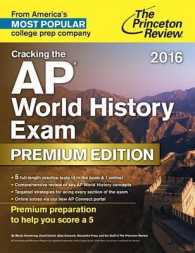- ホーム
- > 洋書
- > 英文書
- > Science / Mathematics
Full Description
InJuly 1982 the first Dartmouth workshop on the corpus callosum took place. A nucleus of basic and clinical scientists was convened to give progress reports of their work on the corpus callosum. This text was subsequently compiled by the various participants from these reports modified by a stimulating cross fertilization of ideas and subsequent studies. Four and one-half decades have intervened since Van Wagenen first sectioned the corpus callosum for epilepsy (Van Wagenen and Herren, 1940) and Erickson (1940) demonstrated that the corpus callosum is the major route for generalization of experimentally induced focal cortical epilepsy. During the succeeding 45 years a handful of clinicians has pursued these leads to confirm the therapeutic value of callosotomy for some types of medically intractable generalized epilepsy. Parallel experimental studies with a number of epilepsy models have indicated that the corpus callosum is indeed the major route for seizure generalization, that the brainstem is a secondary and more resistant pathway for seizure generalization, and that most if not all epileptic seizures originate from the cerbral cortex. The unexpected clinical finding that even partial (focal) seizure incidence is modified by callosotomy now has been demonstrated in the laboratory. The various contributors to the clinical and experimental epilepsy sections of this volume have been seminal in these elucidations, as will be evident from their chapters. The section on the development, anatomy, and physiology of the corpus callosum demonstrates that these basic areas of study have not been neglected.
Contents
I. Anatomy, Development, and Physiology.- 1 Anatomy, Development, and Physiology of the Corpus Callosum.- 2 Some Observations on Trajectories and Topography of Commissural Fibers.- 3 The Organization of Somatosensory Callosal Projections: A New Interpretation.- 4 The Corpus Callosum As a Model System in the Study of Mammalian Cerebral Axons: A Comparison of Results from Primate and Rabbit.- II. Experimental Epilepsy.- 5 Effect of Anterior Two-Thirds Callosal Bisection upon Bisymmetrical and Bisynchronous Generalized Convulsions Kindled from Amygdala in Epileptic Baboon, Papio Papio.- 6 Callosal Mechanisms in Epileptogenesis: Identification of Two Distinct Kinds of Spread of Epileptic Activity.- 7 Generalized Seizure Models and the Corpus Callosum.- 8 The Role of Forebrain Commissures in Kindled Seizure Development.- III. Clinical Epilepsy.- 9 History of Forebrain Commissurotomy.- 10 Corpus Callosum Section for Intractable Epilepsy: Criteria for Patient Selection.- 11 Corpus Callosotomy: Surgical Technique.- 12 Total Corpus Callosotomy for Control of Medically Intractable Epilepsy.- 13 Selective Criteria and Results of Selective Partial Callosotomy.- 14 Anterior Callosotomy in Frontal Lobe Epilepsies.- 15 Electroencephalographic and Clinical Effects of Total Corpus Callosotomy.- 16 Corpus Callosum Section for Control of Clinically and Electroencephalographically Classified Intractable Seizures.- IV. Neuropsychology.- 17 Some Contributions of Split-Brain Studies to the Study of Human Cognition.- 18 The Frequency of Callosal Syndromes in Neurological Practice.- 19 The Integrity of Attentional Control Following Commissural Section.- 20 Bilateral Language and Commissurotomy:Interactions between the Hemispheres with and without the Corpus Callosum.- 21 Observation of Motor Control in Patients with Partial and Complete Callosal Section:Implications for Current Theories of Apraxia.- 22 An Overview of Audiological Test Results in Patients with Commissurotomy.- 23 Neuropsychological Studies on Partial Split-Brain Patients in Japan.- 24 A Remaining Problem in Hemialexia: Tachistoscopic Hemineglect and Hemialexia.- 25 Partial Frontal Callosotomy: A Neuropsychological Frontal Lobe Syndrome Detected in the Background of Improvement of Epilepsy.- 26 Hemisphere Disconnection Effects in Patients with Corpus Callosum Section.- 27 Forebrain Commissurotomy Reinstates Effects of Preexisting Hemisphere Lesions: An Examination of the Hypothesis.- 28 Neuropsychiatric Observations on Behavioral Consequences of Corpus Callosum Section for Seizure Control.- 29 Concluding Overview.







